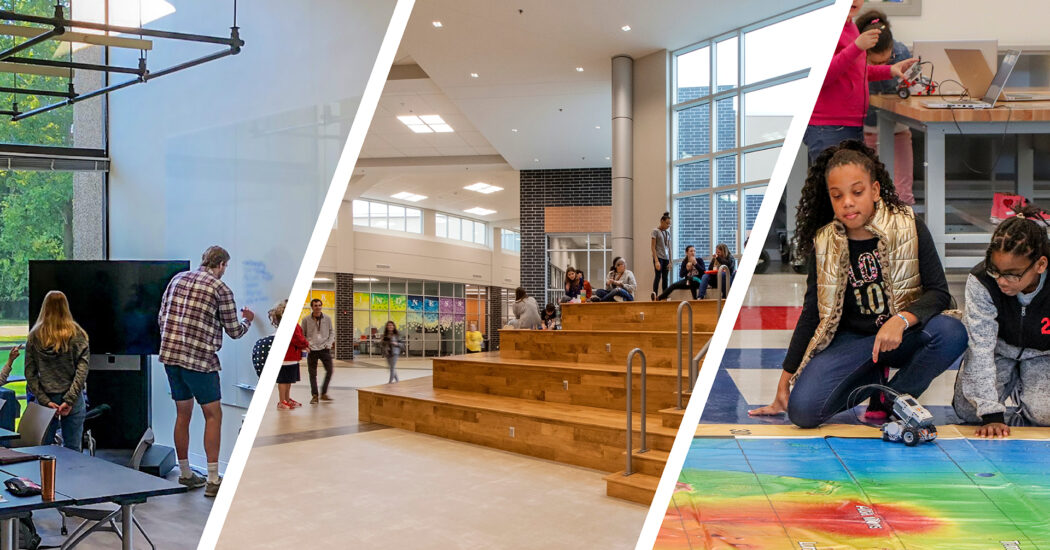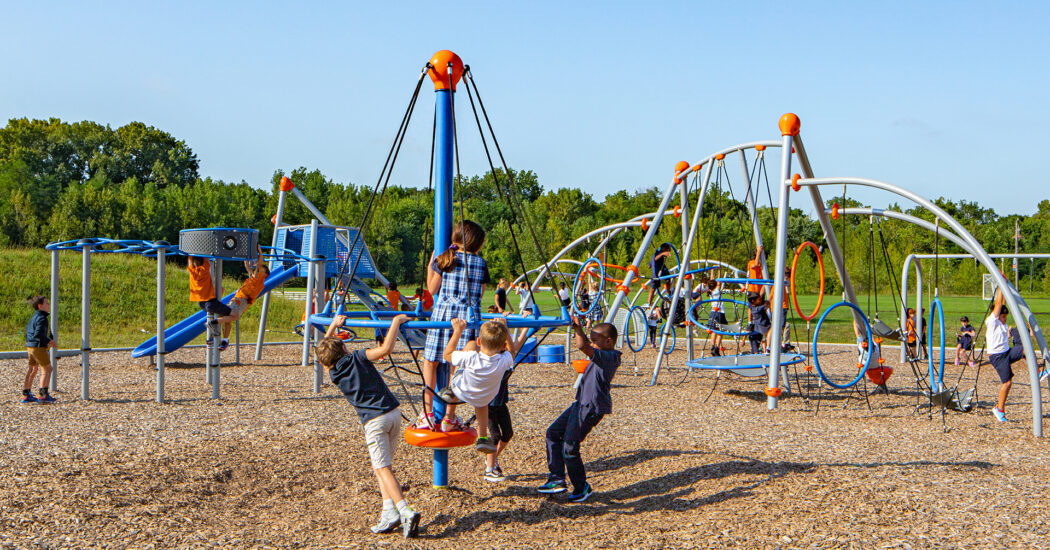Design Components of an Auditorium
-
Category
Studio-K12, Studio-Higher Ed -
Posted By
Steve Schaecher -
Posted On
Feb 17, 2021
Auditoriums and performing arts centers are important features of many K-12 and higher education facilities. They not only host the latest dramatic or musical performance for students, but they can also be used for professional performances, large meetings, community events, and other activities. They are truly an educational and community asset.
Designing auditoriums requires knowledge of specialized pieces and parts—many of which are not apparent to an audience. Below, I’ll describe the major components we consider when designing these spaces.
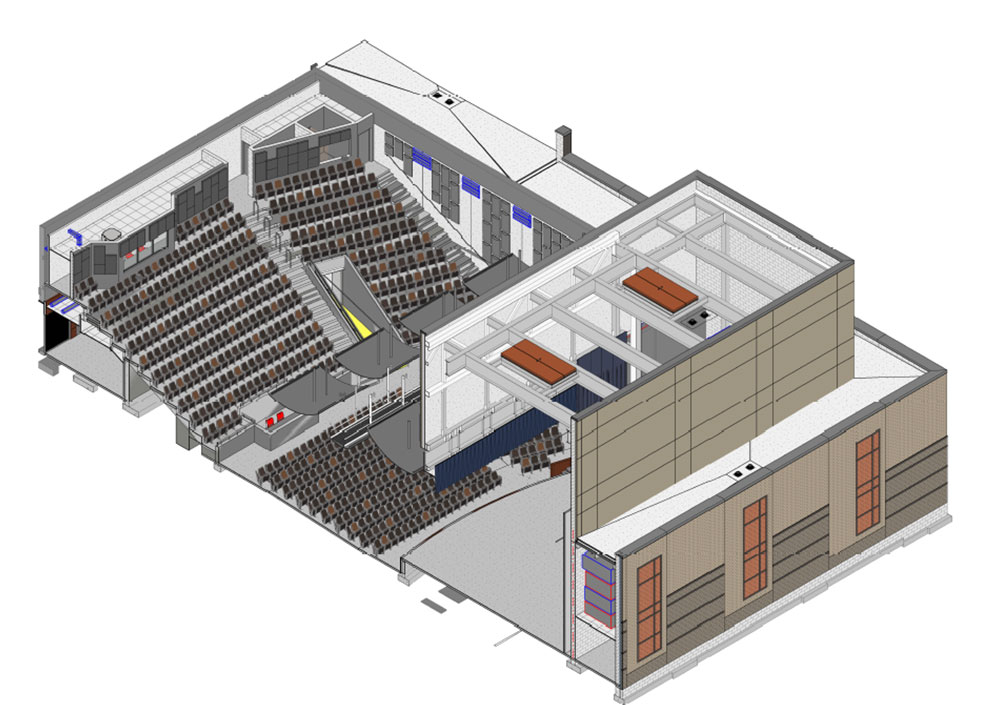
Lobby
While the lobby is not usually an active part of a performance, it is the first entry point into the auditorium and should be looked at just as carefully as any other theatrical space.
Design and Safety Considerations:
- Traffic flow is critical in the lobby, as it needs to accommodate a large crowd going in and out of the house. Consider how many people your auditorium will seat. Most of them will be moving through the lobby at one point, many at the same time.
- Designated spots for gathering can also be helpful in the lobby, allowing actors or other performance members to come out and greet the audience without blocking exits or access to other spaces.
- Adequate signage and wayfinding to help people find their seats, exits, and restrooms will make for safer and more efficient movement of the crowd.
- Your may also see a coat room or a ticket booth connected to the lobby. A ticket booth often serves as a gateway to enter the lobby. Some schools are eliminating physical ticket booths with the increasing use of pre-sold and digital tickets.
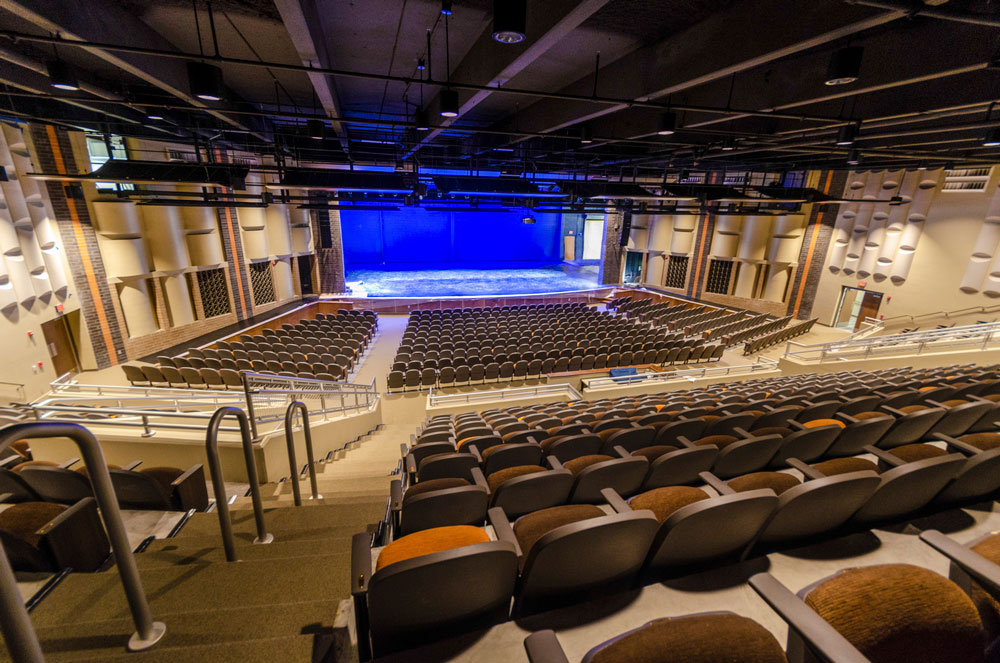

LaPorte High School Performing Arts Center | LaPorte, IN
House
The house is the auditorium’s main seating area. There are many components to the house that make for an enjoyable, accessible, and safe viewing experience for performances and events of all types.
Design and Safety Considerations:
- Adequate space should be planned for the maximum audience size you need your auditorium to accommodate. We typically design for approximately 18 sq. ft. of space per person. This square footage accounts for aisle ways, sound and light control areas, and entryways.
- Viewing angles are of utmost importance for the audience. Most houses are designed with a slope to ensure every seat has visibility to the stage. However, the degree of slope must meet Americans with Disabilities Act (ADA) requirements. Some older auditorium houses have a steeper slope than is permitted by today’s standards.
- In addition to proper slope grade, other features for safe egress and accessibility include clear access to emergency exits, handrails, wheelchair accessible ramps where needed, and proper aisle lighting. It’s also important to consider maintenance of items like seats that automatically raise up to ensure clear paths for people to move.
- Hearing what’s happening on stage is just as important as seeing it! Acoustics are an integral part of house design—to amplify what you want to hear, and quiet what you don’t. We always utilize an acoustician to optimize sound travel throughout this space. Placement of things like acoustical panels so that audience members don’t hit or damage them is also important.
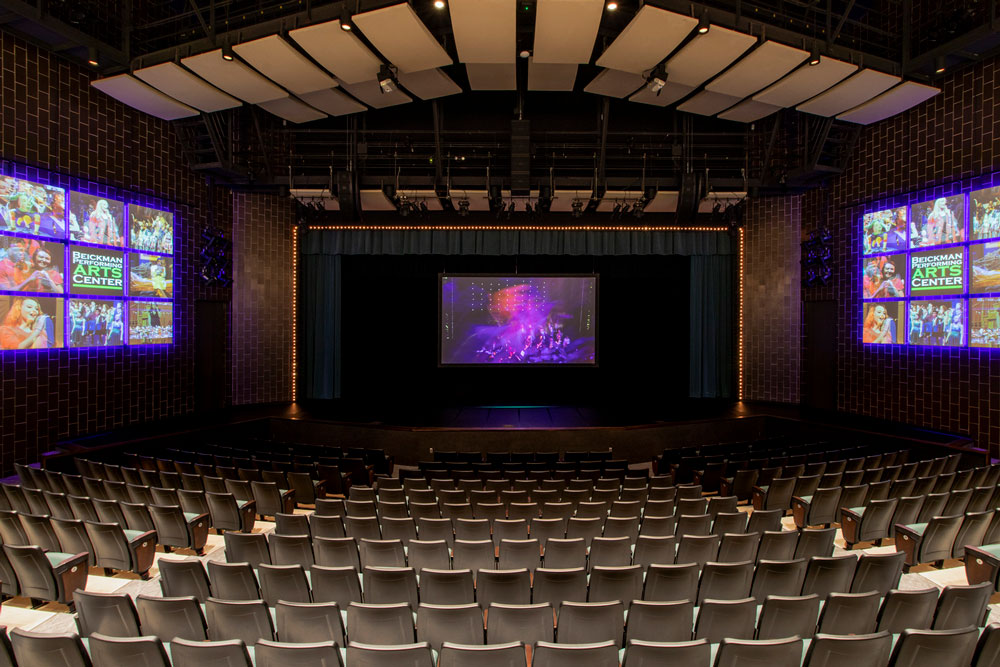

Concord High School Performing Arts Center | Elkhart, IN
Stage
The stage is where the action happens. There are many components that work together on the stage—many not visible from the house—to create a great production for the audience and a safe performance for participants.
Design and Safety Considerations:
- Stages can vary in size, depending on their anticipated uses. When determining stage size, consider the largest production you intend to have. A typical stage is 30-35 ft. deep with an opening (called the proscenium) of approximately 40-45 ft. wide and 30 ft. tall. Stages should be handicap accessible, and the edges of the stage should be lit to prevent falls when the house lights are lowered.
- There are additional components to a stage. Some stages have what is called a “thrust” that protrudes beyond the proscenium out into the audience. There are also side stages, or wings. These should be about half the size of the proscenium width to allow actors and scenery to safely move on and off the stage. The vertical space above the stage is called the “fly.” This is where the curtains are pulled straight up, making this space about as tall as the proscenium. This is why, from the exterior, you will often see a section of an auditorium that is taller than the rest.
- Some stages have an orchestra pit in front. Pits are set lower than the stage so as not to obstruct the view. Some pits have lifts to raise and lower them, allowing them to be used as part of the stage if desired. Pit lifts require special safety and maintenance considerations. Pit fillers can be used if a pit lift is not in the budget. Fillers are large sections of stage floor that are manually moved on and off the pit to create more performance space. Adequate structural support below the fillers is critical for safety.
- Curtains and rigging are very technical aspects of a performance and require close attention and maintenance. We always work with a theater and rigging specialist to design these components according to a school’s performance needs.


Black Box Theater at LaPorte High School and Backstage/Scenery Storage at Warsaw High School
Backstage
A variety of spaces backstage, if designed and utilized well, make the performance on stage go smoothly.
Design and Safety Considerations:
- Scenery construction and storage space backstage should not only accommodate the creation of large scenery pieces and props, but also storage for materials and tools, as well as access to the stage, often in the form of a large overhead door. Exterior access for deliveries or for out-of-house productions to bring in their own scenery can also be important.
- Dressing room space and restrooms for female and male performers should be in proximity to the stage. Monitors that show what is happening on stage help on-deck performers plan for their entrance.
- Flexible black box theater spaces, which can be used for rehearsals or workshopping, are also becoming more popular in high school performing arts centers.
- Proper security in all backstage areas is critical, both to prevent unwanted guests from entering and to prevent performance participants from getting locked out and missing their queue (when trying to use the restroom, for example).
- The green room is typically a space where performers can stay when they are not on stage. In schools, they often double as a classroom with some minor theatrical equipment, like lighting, to help the performers prepare for the stage.
- Costumes are often kept and modified to work for other shows. Costume production shops with appropriate equipment and storage space are important pieces of all auditoriums but are sometimes overlooked.


Control Room at Concord High School Performing Arts Center
Control Room
The control room is a high-tech space central to effective performances.
Design and Safety Considerations:
- Visibility to both the stage and audience is critical for proper lighting and sound control, particularly in performances where actors may travel into the audience. The soundboard may be located in the middle of house seating so the technician can hear what the audience hears and better tune the audio.
- Theater technology has become much more advanced, turning once manual jobs like lighting into programmed tasks. Plan for appropriate space for the equipment and setup you need, as well as a strong internet connection.


Catwalk at Lake Central High School Performing Arts Center | St. John, IN and Tension Grid at Warsaw High School Auditorium | Warsaw, IN
Catwalks and Tension Grids
While technology has made stage lighting easier, you still need access to lighting and other equipment above the stage and house. This can be achieved with catwalks and/or tension grids.
Catwalks are walkways suspended over the house and/or stage. Tension grids cover larger areas with suspended panels and walkable wire cable mesh, which provide more flexibility in lighting and equipment location over the house and stage.
Both systems are hung from the building structure and have height restrictions to avoid obstructing the view of the stage. This means there is low head clearance. These areas should have proper guardrails and fall prevention systems in place, and only trained personnel should be able to access them.





